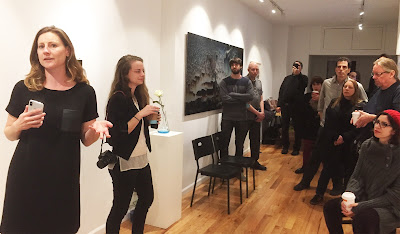An Award Winner by
Kristine Bouyoucos
at
Rochester Contemporary Art Center
Rochester, New York
Has your year been busy as usual? Maybe, political theatre has taken your energy and attention. Sometimes, I just have to turn off all the devices and have some peace and quiet. But then, I want to be part of the discussion and I pick up where I left off, ruminating about the state of the arts.
A popular image "Cuba" by Jim Hartson
at
Rochester Contemporary Art Center
With so many people involved in the visual arts, questions come back around to - why do it at all? What is to be gained from all this activity - to say nothing about the money spent on all those art supplies! Today, there is much more being done in the way of art then there is a paying audience. So, it all comes back to the individual - what do they value? What do they have time for, and how motivated are they in pursuit of their goal?
Lydia Boddie-Rice
" Seeing Clear"
I got involved writing this blog seven years ago because I saw a paucity of coverage for the local visual arts scene to say nothing of trying to make some sense out of all this creative energy. People were investing time and money in this work but who was there to appreciate that except maybe a group of other artists working on their own. How do you get the word out?
Quilted fiber art from Pat Pauly
One place that draws me back for an update every year is the members show at Rochester Contemporary Art Center, and this year seems to have many strong examples of the vitality of our visual arts community. At RoCo you also have a chance to leave your vote ( a yellow dot sticker ) for your own favorite artwork, and if you visit you will see that there is an aggregate of popular votes given to certain standouts.
"Fooling Around With Red"
by
Bill Keyser
I was surprised that some of my choices didn't have a single yellow dot, but certainly deserve some recognition. There are always a few works that leave you wondering - how did that artist create that work? You have to wonder - what is it I am looking at? The work below is one of those - at least for me.
Sorina Susnea at RoCo
Writing for this blog in the past I have mentioned that sculpture does not seem to do well in this circumstance and that seems to be the case again. I am sure that there must be terrific things we are not seeing, and I wonder why there is not more follow through on the part of the membership.
I hope that you still take the time to go through the show and find things that have a strong appeal, maybe you will leave your vote, and respond to the work that you see.
Members Exhibition at RoCo
If your tastes run to something of a natural outdoor scene, you are bound to enjoy the series of small paintings that has recently opened at Axom Gallery in Rochester. Rick Muto is the artist, and he has been painting outdoors en plein aire for many years. You can get drawn into looking at the development of the paintings by making some comparisons. How does Rick Muto indicate trunks of trees, how does he deal with reflections on water, how is the paint applied for rocks on a shoreline...
Axom Gallery and Rick Muto
Rick Muto is into colors and textures, he is a keen observer of light in nature, and these paintings are mostly intimate works done on the spot, so he is responding to what he sees and feels at that certain time and place. These are postcards from the real world, and you just want to take one home and put it up on the wall.
Rick Muto "Embracing the Landscape"
thru January 13, 2018
176 Anderson Avenue, 2nd floor
Rochester, New York
14607




















































